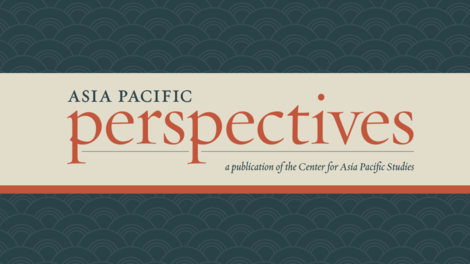
Volume XIV, No. 2: Spring 2017
Editor's Introduction

We are pleased to announce the publication of the Spring 2017 issue of Asia Pacific Perspectives. This issue presents the latest research on the history and life experiences of mixed race individuals in China, Japan, and Korea.
Impressed by the exciting research presented at the University of San Francisco’s symposium “Negotiating Identities: Mixed Race Individuals in China, Japan, and Korea,” we decided to dedicate a special issue to the topic. Our goal for this issue is fourfold: to highlight some of the latest research coming out in the field, to stimulate academic conversations on the topic, to promote greater understanding of the cross-cultural encounters that led to the creation of interracial families, and to encourage further research on how mixed-race individuals living in East Asia have negotiated their identities both historically and today.
The themes highlighted in these papers – including definitions of race (both historical and contemporary) and issues of class, gender, identity, citizenship, and legal rights – reveal the importance of mixed race studies to our understandings of society as a whole. Mixed race studies involves the movement of peoples and the sharing of cultures at the most intimate levels of society – within families. Many of the individual and family histories discussed in this volume were a result of relationships that challenged societal norms. As society questioned their origins and identity, multiracial children – and their descendants – have negotiated their identities and faced challenges, ranging from society’s constant questioning of their social belonging, to legal issues (especially citizenship), to their personal senses of self and identity. By examining the roles played by families, societies, and governments and the reception (or lack thereof) which multiracial individuals have encountered in their lives, these authors reveal how mixed race is more than an individual matter: it is a reflection of the workings of society, the nation, modernity, war, transnationalism, and globalization.
We begin the issue with W. Puck Brecher’s exploration of the treatment and experiences of mixed-race individuals living in Japan during the Pacific War as a lens for understanding racial attitudes during the war. Tracing the experiences of Eurasians living in wartime Japan, Brecher adds another layer of understanding to the race war discourse and encourages us to reconsider characterizations of the war as being fueled by Japanese-Caucasian racial hatred.
Next Vicky Lee examines the diversity of lived experiences among Eurasians in Hong Kong and China during the late 1800s to the 1980s. For these individuals living in colonial Hong Kong and foreign enclaves in China, negotiating their identity necessitated daily strategies ranging from erasure, to solidarity, to duplicity. Highlighting the lives of Eurasians living through the Pacific War and Cultural Revolution, Lee’s study reminds us of the challenges Eurasians faced as they endeavored to be accepted by society, especially during periods of violence and political upheaval.
In our third article, Hyoue Okamura traces the history of the labels used in Japan to refer to “mixed race” individuals and explores the Haafu-gao makeup fad. Focusing on the late 19th century to the present, Okamura’s study traces the terms used to refer to racial mixture and how “haafu” has become the most common label today. Okamura’s cautions that labeling racializes “Japanese” and “foreigners” and results in the categorization of racially mixed people in Japan as not fully Japanese.
We’ve included three important think pieces in this issue to stimulate discussion and encourage further academic research on the topic of “mixed-race” peoples in Asia. Emma J. Teng’s essay encourages us to reflect on how far we have come in the study of mixed-race peoples by examining popular perceptions and academic discourses. Noting the increase in recognition of mixed identities in Asia since the 1990s, Teng notes that “Scholarship on intermarriage, mixed race, and other mixed identities in Asia is flourishing.” Keiko Yamanaka’s essay aims to explore the historical, political and social contexts that have contributed to the interracial/interethnic encounters in Japan and Korea. Yamanaka stresses the importance of understanding multiracial and multiethnic relations over the past 50 years in order to better understand “the emerging multiculturalism and tolerance of ethnic and cultural diversity in East Asia.” Hyoue Okamura’s essay issues a call to action to readers to exercise their “human duty” to “deracialize nationality.” Okamura stresses that racialization and racialist acts have consequences and encourages people to think before they speak and act about how our “acquired habits” contribute to “racializing others”.
Continuing upon a theme first emphasized at the Center’s symposium, of the need for scholars in Asian American Studies and Asian Studies to increase dialogue with one another, we end this issue with Kristin Roebuck’s review of Racial Ambiguity in Asian American Culture by Jennifer Ann Ho.
On behalf of the journal and our authors, I would like to thank Dr. Leslie Woodhouse (Assistant Managing Editor) for her care and dedication in ensuring that our work continues to meet the journal’s high standards.
– Melissa S. Dale, Editor
